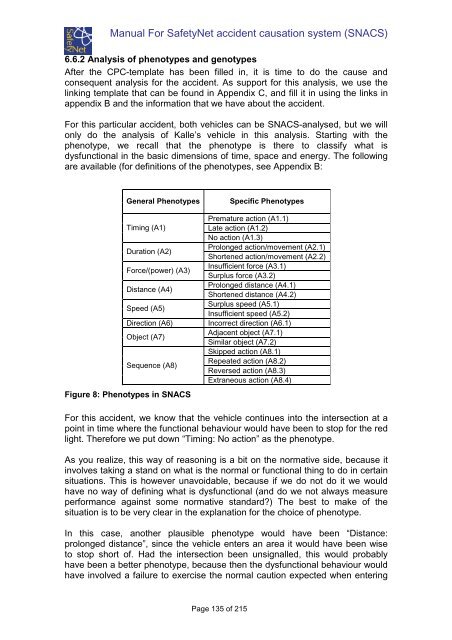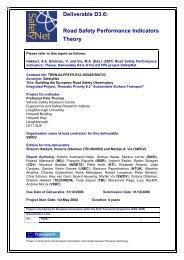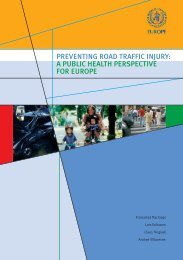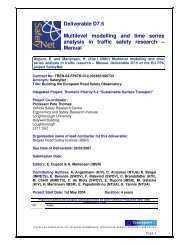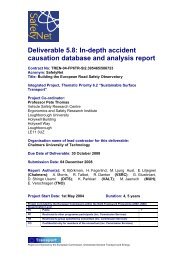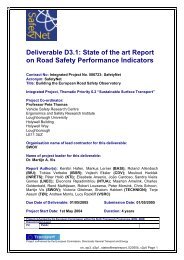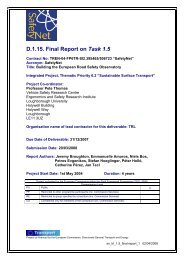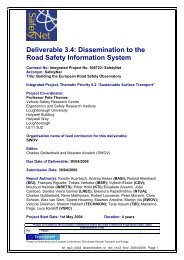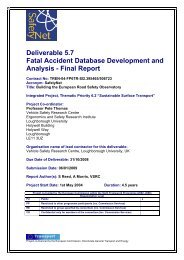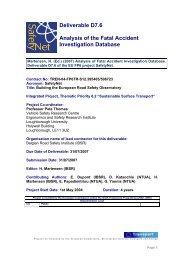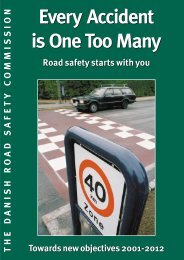Glossary of Data Variables for Fatal and accident causation ... - ERSO
Glossary of Data Variables for Fatal and accident causation ... - ERSO
Glossary of Data Variables for Fatal and accident causation ... - ERSO
You also want an ePaper? Increase the reach of your titles
YUMPU automatically turns print PDFs into web optimized ePapers that Google loves.
Manual For SafetyNet <strong>accident</strong> <strong>causation</strong> system (SNACS)<br />
6.6.2 Analysis <strong>of</strong> phenotypes <strong>and</strong> genotypes<br />
After the CPC-template has been filled in, it is time to do the cause <strong>and</strong><br />
consequent analysis <strong>for</strong> the <strong>accident</strong>. As support <strong>for</strong> this analysis, we use the<br />
linking template that can be found in Appendix C, <strong>and</strong> fill it in using the links in<br />
appendix B <strong>and</strong> the in<strong>for</strong>mation that we have about the <strong>accident</strong>.<br />
For this particular <strong>accident</strong>, both vehicles can be SNACS-analysed, but we will<br />
only do the analysis <strong>of</strong> Kalle’s vehicle in this analysis. Starting with the<br />
phenotype, we recall that the phenotype is there to classify what is<br />
dysfunctional in the basic dimensions <strong>of</strong> time, space <strong>and</strong> energy. The following<br />
are available (<strong>for</strong> definitions <strong>of</strong> the phenotypes, see Appendix B:<br />
General Phenotypes<br />
Timing (A1)<br />
Duration (A2)<br />
Force/(power) (A3)<br />
Distance (A4)<br />
Speed (A5)<br />
Direction (A6)<br />
Object (A7)<br />
Sequence (A8)<br />
Figure 8: Phenotypes in SNACS<br />
Specific Phenotypes<br />
Premature action (A1.1)<br />
Late action (A1.2)<br />
No action (A1.3)<br />
Prolonged action/movement (A2.1)<br />
Shortened action/movement (A2.2)<br />
Insufficient <strong>for</strong>ce (A3.1)<br />
Surplus <strong>for</strong>ce (A3.2)<br />
Prolonged distance (A4.1)<br />
Shortened distance (A4.2)<br />
Surplus speed (A5.1)<br />
Insufficient speed (A5.2)<br />
Incorrect direction (A6.1)<br />
Adjacent object (A7.1)<br />
Similar object (A7.2)<br />
Skipped action (A8.1)<br />
Repeated action (A8.2)<br />
Reversed action (A8.3)<br />
Extraneous action (A8.4)<br />
For this <strong>accident</strong>, we know that the vehicle continues into the intersection at a<br />
point in time where the functional behaviour would have been to stop <strong>for</strong> the red<br />
light. There<strong>for</strong>e we put down “Timing: No action” as the phenotype.<br />
As you realize, this way <strong>of</strong> reasoning is a bit on the normative side, because it<br />
involves taking a st<strong>and</strong> on what is the normal or functional thing to do in certain<br />
situations. This is however unavoidable, because if we do not do it we would<br />
have no way <strong>of</strong> defining what is dysfunctional (<strong>and</strong> do we not always measure<br />
per<strong>for</strong>mance against some normative st<strong>and</strong>ard) The best to make <strong>of</strong> the<br />
situation is to be very clear in the explanation <strong>for</strong> the choice <strong>of</strong> phenotype.<br />
In this case, another plausible phenotype would have been “Distance:<br />
prolonged distance”, since the vehicle enters an area it would have been wise<br />
to stop short <strong>of</strong>. Had the intersection been unsignalled, this would probably<br />
have been a better phenotype, because then the dysfunctional behaviour would<br />
have involved a failure to exercise the normal caution expected when entering<br />
Page 135 <strong>of</strong> 215


